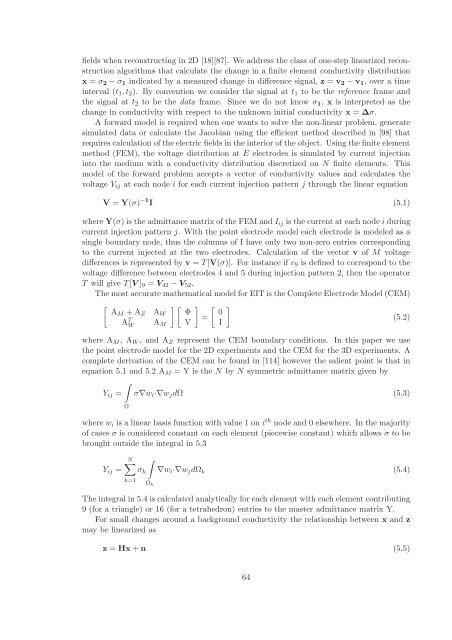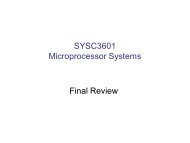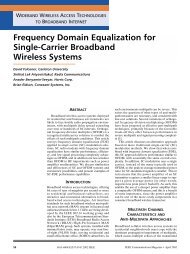Image Reconstruction for 3D Lung Imaging - Department of Systems ...
Image Reconstruction for 3D Lung Imaging - Department of Systems ...
Image Reconstruction for 3D Lung Imaging - Department of Systems ...
Create successful ePaper yourself
Turn your PDF publications into a flip-book with our unique Google optimized e-Paper software.
fields when reconstructing in 2D [18][87]. We address the class <strong>of</strong> one-step linearized reconstruction<br />
algorithms that calculate the change in a finite element conductivity distribution<br />
x = σ2 − σ1 indicated by a measured change in difference signal, z = v2 − v1, over a time<br />
interval (t1,t2). By convention we consider the signal at t1 to be the reference frame and<br />
the signal at t2 to be the data frame. Since we do not know σ1, x is interpreted as the<br />
change in conductivity with respect to the unknown initial conductivity x = ∆σ.<br />
A <strong>for</strong>ward model is required when one wants to solve the non-linear problem, generate<br />
simulated data or calculate the Jacobian using the efficient method described in [98] that<br />
requires calculation <strong>of</strong> the electric fields in the interior <strong>of</strong> the object. Using the finite element<br />
method (FEM), the voltage distribution at E electrodes is simulated by current injection<br />
into the medium with a conductivity distribution discretized on N finite elements. This<br />
model <strong>of</strong> the <strong>for</strong>ward problem accepts a vector <strong>of</strong> conductivity values and calculates the<br />
voltage Vij at each node i <strong>for</strong> each current injection pattern j through the linear equation<br />
V = Y(σ) −1 I (5.1)<br />
where Y(σ) is the admittance matrix <strong>of</strong> the FEM and Iij is the current at each node i during<br />
current injection pattern j. With the point electrode model each electrode is modeled as a<br />
single boundary node, thus the columns <strong>of</strong> I have only two non-zero entries corresponding<br />
to the current injected at the two electrodes. Calculation <strong>of</strong> the vector v <strong>of</strong> M voltage<br />
differences is represented by v = T[V(σ)]. For instance if v9 is defined to correspond to the<br />
voltage difference between electrodes 4 and 5 during injection pattern 2, then the operator<br />
T will give T[V ]9 = V42 − V52.<br />
The most accurate mathematical model <strong>for</strong> EIT is the Complete Electrode Model (CEM)<br />
� AM + AZ AW<br />
A T W<br />
AM<br />
�� Φ<br />
V<br />
�<br />
=<br />
� 0<br />
I<br />
�<br />
(5.2)<br />
where AM, AW, and AZ represent the CEM boundary conditions. In this paper we use<br />
the point electrode model <strong>for</strong> the 2D experiments and the CEM <strong>for</strong> the <strong>3D</strong> experiments. A<br />
complete derivation <strong>of</strong> the CEM can be found in [114] however the salient point is that in<br />
equation 5.1 and 5.2 AM = Y is the N by N symmetric admittance matrix given by<br />
�<br />
Yij = σ∇wi·∇wjdΩ (5.3)<br />
Ω<br />
where wi is a linear basis function with value 1 on i th node and 0 elsewhere. In the majority<br />
<strong>of</strong> cases σ is considered constant on each element (piecewise constant) which allows σ to be<br />
brought outside the integral in 5.3<br />
Yij =<br />
N�<br />
k=1<br />
σk<br />
�<br />
Ωk<br />
∇wi·∇wjdΩk<br />
(5.4)<br />
The integral in 5.4 is calculated analytically <strong>for</strong> each element with each element contributing<br />
9 (<strong>for</strong> a triangle) or 16 (<strong>for</strong> a tetrahedron) entries to the master admittance matrix Y.<br />
For small changes around a background conductivity the relationship between x and z<br />
may be linearized as<br />
z = Hx + n (5.5)<br />
64





